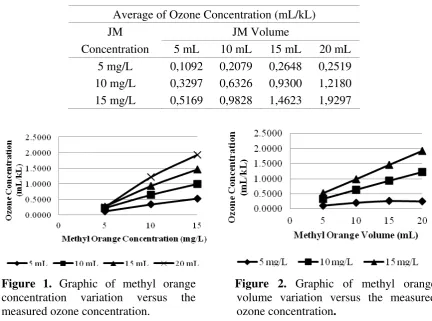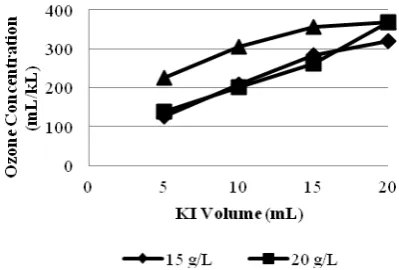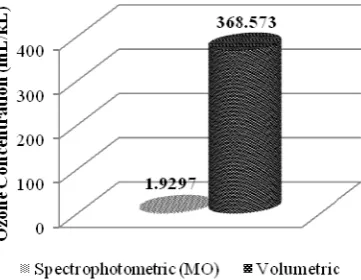The journal homepage www.jpacr.ub.ac.id ISSN : 2302‐4690
18
Ozone Determination: A Comparison of Quantitative Analysis
Methods
Rachmat Triandi Tjahjanto,1* Dhesy Galuh R.,1 and Sri Wardani1
1
Laboratory of Inorganic Chemistry, Department of Chemistry, Brawijaya University, Jl. Veteran 65145 Malang, East Java - Indonesia
Email contact : rachmat_t@ub.ac.id
Received 25 May 2012, Accepted 27 June 2012
ABSTRACT
A comparison of ozone quantitative analysis methods by using spectrophotometric and volumetric method has been studied. The aim of this research is to determine the better method by considering the effect of reagent concentration and volume on the measured ozone concentration. Ozone which was analyzed in this research was synthesized from air, then it is used to ozonize methyl orange and potassium iodide solutions at different concentration and volume. Ozonation was held for 20 minutes with 363 mL/minutes air flow rates. The concentrations of ozonized methyl orange and potassium iodide solutions was analyzed by spectrophotometric and volumetric method, respectively. The result of this research shows that concentration and volume of reagent having an effect on the measured ozone concentration. Based on the results of both methods, it can be concluded that volumetric method is better than spectrophotometric method.
Keywords: comparison, spectrophotometric, volumetric, methyl orange, potassium iodide
INTRODUCTION
Ozone is an oxygen allotrope of which three atoms are bound together to form a molecule. It exists mostly in the stratosphere layer and in small amount in troposphere [1]. Ozone in these layers formed through absorption of ultaviolet radiation by oxygen molecule in the air, which followed by the breaking of that molecule as radicals. The radical species join any intact oxygen molecule to form ozone [2].
In this recent time, the rapid growth of technology and the utilizing of ozone broadly support the researchers to develop methods to synthesize ozone. Various methods have been developed to synthesize ozone, which is useful for research or industry appliances. Nowadays, there have been four methods to produce ozone, namely electrical discharge, ultraviolet light radiation, electrolysis and radiochemistry methods [3].
The main usage of ozone nowadays is for industrial application, used for either industrial processes or waste management [1]. In the industrial process, ozone is used as disinfectant before the packaging process, disinfectant in bottled water industry and food preservative. In the process of waste management, ozone functions as effective disinfectant, so that the resulting waste, can be accepted by the environment. It is therefore necessary to know the method of analysis to determine the concentration of ozone produced by an ozone reactor.
The journal homepage www.jpacr.ub.ac.id ISSN : 2302‐4690
19 concentration of ozone is iodometric titration. First of all, solution of KI with acid buffer [5] or neutral buffer [6] is bubbled gas – a mixture containing ozone to produce iodine (I2). Then, iodine solution is adjusted its pH to 2 [6] titrated directly with titrant solution sodium thiosulfate and starch indicator. Neutral buffer method resulting in ozone concentration 15 – 30% more than potassium iodide without buffer and potassium iodide with weaker buffer capacity.
Determination of ozone concentration by volumetric method is easy and relatively simple. However it tends to be conventional method and the process takes a long time. Hence further study about another method that is more modern and faster is necessary. The applicable instrument-based method that can be used are spectrophotometric. According to Rana [4], spectrophotometric method for the determination of ozone concentration can be performed by using a colored reagent which the wavelength absorption under ultraviolet and visible light. The colored reagent used in this study was methyl orange. Methyl orange was chosen as the reagent because it is one of the most common dye used as an indicator solution for titration in the laboratory and it fades when oxidized. In this study, the quantitative analysis of ozone was carried out using two methods, namely volumetric and spectrophotometric methods. The aims of this research were to compare the two methods, which one is better for quantitative analysis of ozone by variation of reagent concentration and volume. It is because reagent concentration can influence the amount of measured ozone concentrations [7,8]. The reagent volume is also an important factor that can affect the measured ozone concentrations, but there has not been any research that studies this factor yet.
The ozone were analyzed in this study was synthesized from the air. The resulted ozone is used to ozonize the reagent, namely methyl orange and potassium iodide solution. Ozonation was held for 20 minutes with 363 mL/min air flow rate [9]. Reagent that has been ozonized, then were analyzed and the results were compared to determine which method is better based on the measured ozone concentrations.
EXPERIMENTAL Materials
Ozone was synthesized from the air with plasma discharge method, potassium iodide (KI), methyl orange, potassium iodate (KIO3), starch, sodium thiosulfate pentahydrate (Na2S2O3.5H2O), concentrated H2SO4 (96%, ρ = 1.84 g/mL), Na2HPO4, KH2PO4 obtained from Merck in PA grade, technical KOH pellets, and distilled water.
Apparatus
The instrumentation used for the experiment was a set of homemade ozonator [9], digital flowmeter HF-10 Digital Flow Checker, InoLab pH meter, magnetic stirrer IKAMAG®RH, 1 cm stir bar, Fischer Scientific water bath, glassware, analytical balance Mettler AE 50 and PE 300, and UV-Vis spectrophotometer Shimadzu 1601.
Preparation of Reagents for The Determination of Ozone Concentration
The journal homepage www.jpacr.ub.ac.id ISSN : 2302‐4690
20
Synthesis of Ozone from The Air and Ozonation
A set of tools used for the synthesis of ozone from the air consists of an air pump that will suck in air to get into the ozone reactor through a tube containing KOH pellets and through the flowmeter. Ozone in the reactor will take place the formation of ozone from dry air with an electric discharge method, then the generated ozone is passed through a tube which is inert to the oxidation of silicon into the container containing the test reagent. Ozonation was done by putting the reagent solution in cylinder glass (length = 40 cm and diameter = 1 cm). Ozone was brought into contact with the solution for 20 min with 363 mL/min air flow rates while being stirred by magnetic stirrer.
Determination of Ozone Concentration by Spectrophotometric Method
Determination of ozone concentration was done by ozonation of 5 mL methyl orange solution 5 mg/L. After ozonation, solution was diluted with distilled water until the pH is equal to the initial pH. The absorbance of methyl orange solution was then measured using a UV-Vis spectrophotometer at maximum absorption wavelength of 460 nm. Ozone concentration is determined based on the assumption that the number of moles of methyl orange oxidized is directly proportional to the number of moles of ozone to oxidize. This procedure is performed also for methyl orange solution with a concentration of 10 mg/L and 15 mg/L, as well as to the amount of methyl orange solution 10, 15 and 20 mL. Ozonation procedure was held three times.
Determination of Ozone Concentration by Volumetric Method
Volumetric method for determining concentrations of ozone have been carried out by ozonation of 5 mL KI solution of 15 g/L with phosphate buffer pH 7 solvent. KI solution that has been exposed to ozone was then added with a solution of 0.5 M H2SO4 to pH 2, then titrated with 0.07 M Na2S2O3 solution that has been standardized [10] until it turned pale yellow color. Then, 1% starch indicator solution of 0.5 mL was added and the titration continued until the titration end point, i.e. when a blue color changes to colorless. The procedure was repeated for the concentration of KI solution of 20 g/L and 25 g/L, as well as to the volume of KI solution 10, 15 and 20 mL. Determination of the concentration, at each combination of volume and concentrations, repeated three times, while the ozone concentration calculated by the stoichiometric equation, i.e. the number of moles of iodine formed is directly proportional to the number of moles of ozone to oxidize.
Comparison of Methods
The journal homepage www.jpacr.ub.ac.id ISSN : 2302‐4690
21
RESULT AND DISCUSSION
The Effect of Methyl Orange Concentration and Volume on The Measured Ozone Concentration by Spectrophotometric Method
The average of ozone concentrations measured by the spectrophotometric method were shown in Table 1. The effect of methyl orange concentration on the measured ozone concentration were shown in Figure 1, whereas the effect of methyl orange volume were shown in Figure 2.
Table 1. The average of measured ozone concentration
(ml/kl) by spectrophotometric method with variation of methyl orange volume and concentration
Average of Ozone Concentration (mL/kL)
JM JM Volume
Concentration 5 mL 10 mL 15 mL 20 mL 5 mg/L 0,1092 0,2079 0,2648 0,2519 10 mg/L 0,3297 0,6326 0,9300 1,2180 15 mg/L 0,5169 0,9828 1,4623 1,9297
Figure 1. Graphic of methyl orange
concentration variation versus the measured ozone concentration.
Figure 2. Graphic of methyl orange
volume variation versus the measured ozone concentration.
Generally, Figure 1 and Figure 2 show that the measured ozone concentration would increase with the increasing methyl orange concentration and volume. This is due to the increasing methyl orange concentration and volume which will increase the collision number and contact time between ozone and methyl orange molecule. Finally, the measured ozone concentration would also increase.
The journal homepage www.jpacr.ub.ac.id ISSN : 2302‐4690
22 The cleavage of azo bond in the molecule of methyl orange can be observed by decreasing of the methyl orange color after ozonation, which means reduction in the concentration of methyl orange. The destruction of methyl orange solution may involve formation of intermediate compounds, namely 4-aminoazobenzene and sulfonic acid p-hydroxibenzene derivatives [8]
The Effect of Potassium Iodide Concentration and Volume on The Measured Ozone Concentration by Volumetric Method
Determination of ozone concentration by the volumetric method is based on the reaction between ozone and potassium iodide that were shown in Equation (1) and (2):
O3 + 2KI + H2O I2 + O2 + 2KOH (1) I2 + I- Æ I3- (2)
In excess of potassium iodide concentration, iodine would reacts with iodide ion to form triiodide ion which caused the solution color change to pale yellow. The average of measured ozone concentrations by volumetric method were shown in Table 2. The effect of potassium iodide concentration and volume on the measured ozone concentrations were shown in Figure 3 and Figure 4, respectively.
Table 2. The Average of Measured Ozone Concentration
(mL/kL) by Volumetric Method With Variation of Potassium Iodide Volume and Concentration
Average of Ozone Concentration (mL/kL)
KI KI Volume
Concentration 5 mL 10 mL 15 mL 20 mL 15 g/L 125,4633 209,7767 284,2033 319,5067 20 g/L 139,2100 201,9233 262,7033 368,5733 25 g/L 225,4567 305,8400 356,8100 368,5733
The journal homepage www.jpacr.ub.ac.id ISSN : 2302‐4690
23
Figure 3. Graphic of potassium iodide
concentration variation versus the measured ozone concentration
Figure 4. Graphic of potassium iodide
volume variation versus the measured ozone concentration
Figure 4 shows that for concentration of 20 g/L the increasing measured ozone concentration was not significant at volume 10 mL and 15 mL. When compared with the concentration of 15 g/L, at the same sample volume values of the measured ozone concentration is still lower. This may due to the starch end point determination, between one solution and another was different, so the chance for an error to occur is big enough. The difficulty of starch end point determination made the volumetric method has low precision. In addition, the period between the the reagent solution acidified until the titration was done, also determine the amount of measured ozone concentration because it is possible to occur from the oxidation of iodide to iodine by oxygen from the air.
Comparison of Methyl Orange Spectrophotometric and Volumetric Method
Figure 5 showed that ozone concentration of measuring result by methyl orange spectrophotometric method was extremely different than volumetric method. The difference is caused of oxidation reaction of methyl orange occurred by the cleavage of azo bound from ozone or hydroxyl radical, besides iodide ion oxidation is occurred by electron transfer to O atom released from O3, so it change iodide ion to iodine. By noting that there are two aromatic rings connected by azo bound causes more difficulties for ozone or hydroxyl radical to attack the azo bond. In addition, it is also possible that ozone or hydroxyl radical does not attack azo bound but attacks the formed of intermediate compound. The steric effect is not occurred in iodide ion because iodide ion tends to be round shape. It causes ozone or hydroxyl radical can attack iodide ion from any direction easily. Therefore, ozone concentration of measuring result by methyl orange spectrophotometric method is lower than volumetric method.
The journal homepage www.jpacr.ub.ac.id ISSN : 2302‐4690
24
Figure 5. Comparison graphic of the average ozone concentration from measurement by
methyl orange spectrophotometric and volumetric method
Based on the data of ozonated potassium iodide absorbance is that iodine (I2) concentration is proportional with ozone concentration. The average of measured ozone concentration is 438,147 mL/kL. The result shows that ozone concentration from volumetric method approachs the ozone concentration from potassium iodide spectrophotometric method.
CONCLUSION
Based on this research and discussion we can conclude that:
1. The measured ozone concentration will increase with the increasing concentration and volume of ozonized methyl orange and potassium iodide solution
2. The better method to determine ozone concentration is volumetric method
REFERENCES
[1] B. Yusuf, A. Warsito, A. Syakur, I. N. Widiasa, Final Task, Department of Electrical Engineering, Faculty of Engineering, Diponegoro University, Indonesia, 2008.
[2] B. N. Chapman, Glow Discharge Processes, John Willey and Sons, New York, 1990.
[3] W. Smith, Principles of Ozone Generation, Watertec Engineering Pty Ltd., Australia,
2011.
[4] S.V.S. Rana, Biotechniques Theory and Practice, Rastogi Publication, New Delhi,
2009, p. 229.
[5] N.N. Greenwood, A. Earnshaw, Chemistry of The Elements Second Edition, Butterworth-Heinemann, Linacre House, Jordan Hill, Great Britain, 1998, p. 609.
[6] Gordon, G., K. Rakness, D. Vornehm, D. Wood, Journal Awwa Research and Technology, 1989, 72-76.
[7] H. Zhang, L. Duan, D. Zhang, Decoloration of Methyl Orange by Ozonation in Combination with Ultrasonic Irradiation China, 2006 www.aseanenvironment.info/Abstract/41014007.pdf
[8] L. C. Chen, Wat. Res., 1999, 34 (3), 974-982.
[9] U. Anggraini, Undergraduate Thesis, Department of Chemistry, Faculty of Mathematics and Natural Sciences, Brawijaya University, Indonesia, 2011.
The journal homepage www.jpacr.ub.ac.id ISSN : 2302‐4690
25 [11] N. Okafor, Environmental Microbiology of Aquatic and Waste Systems, Springer
Science Bussiness Media B.V, England, 2011, p. 227-229.


